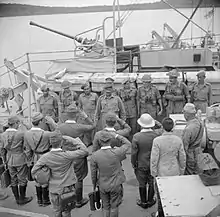Thakur Nathu Singh Rathore | |
|---|---|
| Born | 22 April 1900 Gumanpura, Dungarpur, Rajasthan |
| Died | 5 November 1994 (aged 94) Gumanpura, Dungarpur, Rajasthan |
| Allegiance | British India (1922–1947) India (from 1947) |
| Service/ | British Indian Army (1922-1947) Indian Army (1947-1954) |
| Years of service | 1922-1954 |
| Rank | Lieutenant General |
| Unit | Rajput Regiment |
| Commands held | Eastern Command |
| Battles/wars | World War II Indo-Pakistani War of 1947 |
| Relations | Ran Vijay Singh (son)[1] |
Lieutenant General Nathu Singh Rathore was an Indian Army officer from Gumanpura, Rajasthan.[2]
Early years
Singh was born in 1900,[3] although official records say he was born on 10 May 1902 at Gumanpura in the princely state of Dungarpur. He was the only son of Thakur Hamir Singhji of Gumanpura. He was a descendant of Jaimal Rathore who fought for Mewar against Akbar. Singh lost his parents at a young age and was then taken under the wing of Maharawal Vijay Singh of Dungarpur.
Singh was educated at Mayo College and was nicknamed Baghi (Rebel) by his peers. He was later sent to the Royal Military College, Sandhurst in England to be trained as an officer to serve in the Mewar Army, on the request of Rajmata of Dungarpur.
Career
Singh was the second Indian officer to graduate from Sandhurst, after Rajendrasinhji Jadeja who later became a three-star general. After serving in the Mewar Army, he was commissioned in the 1/7 Rajput Regiment in 1925. He served at various places including Afghanistan and the Deccan. At Staff College Camberley, he scored a still-record 935 out of 1000 in Strategy. He served as a Division Commander in Burma during World War II.[4]
Singh climbed the military hierarchy and in 1947 was offered the post of Commander-in-Chief of the Indian army to replace the retiring General Roy Bucher by Sardar Baldev Singh, the defence minister at the time.[5] He declined, stating that General K. M. Cariappa was senior to him and more eligible for the post. He was instead appointed first as the Inspector-General of Training and Evaluation, and then in 1951 as the commander of the Eastern Army, a post he held till 1954.[5][6]

References
- ↑ Singh 2005, p. 59
- ↑ Singh 2005, p. 55
- ↑ Singh 2005, p. 56
- ↑ Pradeep Barua, Gentlemen of the Raj: the Indian Army Officer Corps, 1817-1949
- 1 2 Singh 2005, p. 38
- ↑ Rajendra Nath, Military leadership in India:Vedic period to Indo-Pak wars, page 15
Bibliography
- Singh, V. K. (2005). Leadership in the Indian army: biographies of twelve soldiers. ISBN 978-0761933229.